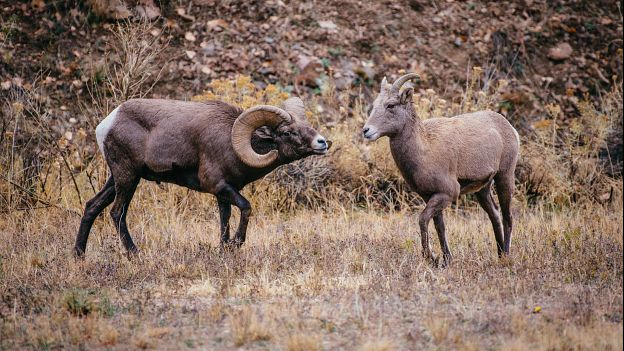Rocky Mountain Bighorn Sheep
Colorado's state animal and the mammalian mascot of Colorado Parks and Wildlife, the Rocky Mountain bighorn sheep spend their lives on the cliffs and rocky faces across central and western Colorado.

About This Species
The bighorn sheep is the mammalian symbol of Colorado Parks and Wildlife and Colorado's official animal. Colorado is home to the largest population of the species anywhere.
Usually, bighorn sheep are diurnal, being active during daylight and exhibit little nocturnal (nighttime) activity. Adult rams stay segregated from ewes, except during the rut. Rams battle each other, cracking horns, to test dominance within the herd.
Hunting bighorns is carefully regulated. Parasitic disease is common in bighorns. Coyotes, mountain lions and eagles prey on them, and some bighorns succumb to accidental falls. Bighorns can live to be 15 to 20 years old, but seldom do in the wild.
Conservation and Research
Despite its iconic status and current prominence, the bighorn sheep was near extinction at the turn of the century. Diseases introduced through European livestock and unregulated hunting had decimated populations throughout the West, and only a small number of the native sheep remained in Colorado in the early 1900s.
Thanks to the creation of the North American Model of Wildlife Conservation and the work done in Colorado over the past century bighorn sheep along are doing very well. This model takes funding from the sale of hunting and fishing licenses to invest into wildlife management, research and habitat enhancement.
In cooperation with the Rocky Mountain Bighorn Society, we have spent decades rebuilding sheep populations through trapping and relocation efforts.
CPW conducted the first sheep transplants in the 1940s, including planting bighorns between Georgetown and Silver Plume. Known simply as the "Georgetown Herd," this population of 250-350 sheep is one of the largest herds in the state and the area has become one of the most popular sheep viewing sites in the nation.
Since Colorado's restoration efforts began, CPW has completed more than 100 bighorn sheep transplants, most of which took place in the 1970s and 1980s. Gore Canyon in northwest Colorado is one of the most recent transplant locations. CPW closely monitors bighorn sheep herds and maintains healthy populations through controlled hunting and ongoing trapping and relocation. Thanks to decades of dedicated conservation efforts, Colorado's iconic bighorn sheep are once again abundant with an estimated statewide population of 7,000 animals.
1940s
Colorado Parks and Wildlife conducted the first sheep transplants including planting bighorns between Georgetown and Silver Plume.
1970s-1980s
Colorado Parks and Wildlife completed more than 100 bighorn sheep transplants
250-350
sheep, the "Georgetown Herd," is one of the largest herds in the state and the area has become one of the most popular sheep viewing sites in the nation.
More Information:
Physical Characteristics
The animals are five to six feet long with a tail three to six inches in length. Rams weigh 150-250 pounds, ewes 120-200. Males are about three feet high at the shoulder, ewes slightly less. Color is usually grayish brown, with a paler belly and a white rump patch. The massive, coiled horns of mature rams may make up to 10 percent of the body weight. Ewes have spike-like horns.
“Brooming” is the term used to describe the chipping and fraying of horns, usually caused by fighting. Some brooming may be caused by accidents or digging. Rams achieve “full curl” at about seven or eight years of age.
Range
There are two species of bighorn in Colorado, the Rocky Mountain, which is native, and the desert bighorn, introduced near Colorado National Monument in 1979. Colorado herds are widely scattered throughout the mountains and foothills of the state. In North America, species of bighorn occur from South British Columbia, southwest Alberta, Idaho and Montana to southeast California, Arizona and New Mexico.
Habitat
Bighorns typically occur in steep, high mountain terrain. In Colorado, they prefer habitat dominated by grass, low shrubs, rock cover and areas near open escape. They often retreat to rest on inaccessible cliffs. Many bands now spend all year near timberline on what used to be their traditional summer range.
Diet
Bighorn are primarily grazers, feeding in meadows, open woodland, and alpine tundra. However, they will also eat forbs (herbaceous plants) in the summer and browse in the winter. Grasses eaten by bighorn include bluegrass, sedges, wheat grass, bromes and fescues. Browse includes willow, mountain mahogany, winterfat and bitter brush. Forbs include clover, cinquefoil and phlox.
Reproduction
Gestation averages five to six months or about 175 days. Breeding occurs in November and December with a peak in early December. Lambs are born April through July, with the peak in late May and early June. A single lamb is the norm. Lambs can climb as well as their mothers when they are only a day old. Lambs are weaned at about four months, and sometimes as early as one month. All teeth are permanent by four years old. Ewes usually live to be 10 to 12 years old. Rams seem to have a somewhat higher mortality rate. Young rams join bands of rams when they are two to three years old.
Threats to Species
- Pathogens
- Energy Development and Land Use
- Poaching